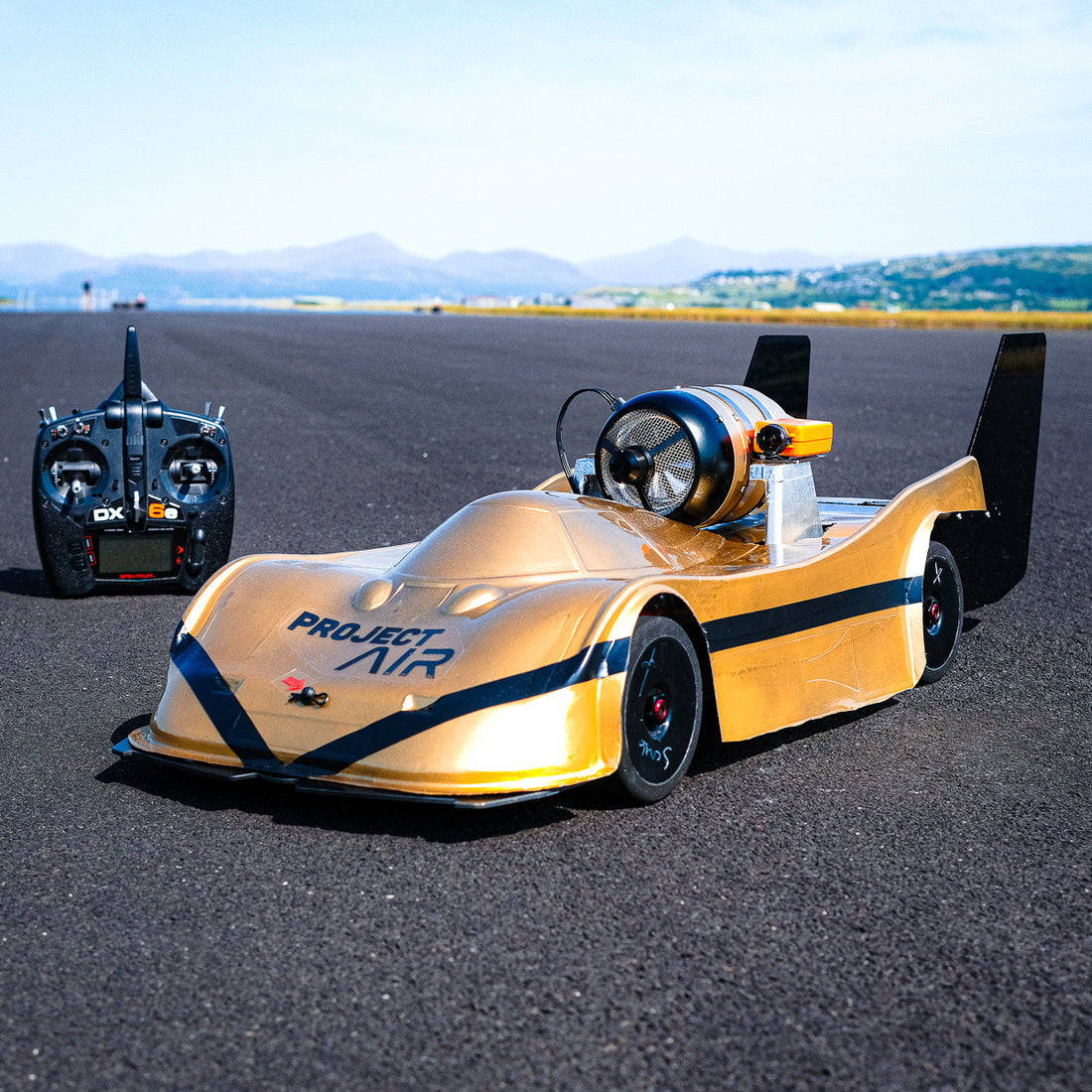I built a land speed record inspired RC car and have been hard at work developing its control systems, brakes and parachute while trying not to destroy the rather expensive and scary jet engine, or get myself killed.
In this video you’ll see how I went about modifying this Arrma Limitless RC car by doing the most extreme engine swap possible.
So how did I get to a point where I was willing to strap a jet engine to the top of a ready to run RC car? If you look at the wide array of subjects on my channel from rockets to planes to racing cars, you could probably have guessed I’m into Land Speed Record cars too.
There’s something super interesting the idea of pushing materials and technology to the maximum combined with the human element; who can be brave enough to keep that throttle open and push beyond the envelope of what’s possible.
I haven’t quite got the budget to build anything to take to Bonneville salt flats or the black rock desert yet, so I want to build a jet powered model car to gain some experience in the meantime. So, the other day, when I was looking at my old Arrma Limitless used in the RC Car Extreme Aerodynamics video, I thought, you know what, why not stick the two together and see what happens. Here’s what happened next
Building the Car
The goal initially was simply to mess around with the car and get it to drive along under pure jet power, because I hadn’t ever seen that before. I started taring the car down, starting by removing the body, battery mounts and wings.
The engine is made by a company called Swiwin and is intended for use in large scale RC jet planes. It produces around 120 Newtons of thrust when at full throttle, which is equivalent to a force of around 12kg. The stock Arrma Limitless car weighs in at just under 6kg, meaning it will have a thrust to weight ratio of more than 2:1! This means if this car was an aircraft, it would be able to climb vertically with no problem.
To give them some more thermal protection, I wrapped them in aluminium foil which would reflect some of the heat.I hadn’t measured the temperature around the engine, but on previous runs, the test stand hadn’t felt hot to the touch. To install the mount permanently, I drilled several holes in the chassis to bolt the engine mounts down. Then I could bolt on the engine.
I could now position the ECU and other electronics for controlling the engine, hook up the radio receiver and install the fuel tank. At this point the car sort of resembled Richard Nobels original Thrust experimental car which was just intended to be a learning platform. So, I did the minimum amount of work to get to the point where I could fire up the car and see if it moved.

Now, I expected that the engine would have to throttle up a bit to overcome the static inertia of the 6kg car to get it moving, but I found out quite quickly that I needed to keep my foot in front of it to stop it accelerating away.

Brakes
So, time to tackle that small issue. How was I going to get the car to stop? How was I going to build some breaks that could significantly slow the car and hold it when the engine was at idle.
All of my other RC cars simply use electric motors to slow down. However, my car didn’t have a motor as I wanted to keep this car a pure jet car, powered only by the turbine like jet land speed record cars. Real cars use big old disk brakes which work through the calliper, here, squeezing brake pads onto this metal disk.
Initially I thought about building little disk brakes and callipers into the axle hubs of the RC car, but then I realised that I could potentially make the job a lot simpler by reconnecting the wheels together with the drive shafts that go to the motor. This way I could get away with using a single disk on this prop shaft. I started designing a system before realising that a ready made product was available that is intended to make your RC car do a handbrake turn, using a servo to grip the disk really hard.
I assembled this kit and set it up so the servo would instead softly squeeze it with more an more force when moving this control stick on my transmitter. Problem was that this kit was designed for another RC car and wouldn’t fit onto mine, but some drastic action with a Dremel and a sanding disk soon solved that.
I only linked up the prop shaft to the rear wheels, but later I could decide to link up the front wheels too as this RC car is actually four wheel drive. I’d have to test to find out what would work best. I also set up a switch on my transmitter to work like a handbrake so I could fully engage the servo when I wanted the car to stay still when the engine was ramping up.

Test 2
Now I had a way of preventing the car from accelerating away. It was pretty cool to see an RC car being propelled along purely through a jet turbine engine. At idle power, the car would accelerate away to around 10-15mph and wouldn’t stop without the brakes.
I wanted to see how well the brakes worked, so gave it some beans with the handbrake on. However, the high thrust line meant that the rear wheels simply scrubbed along behind. I didn’t have a great location to test out the car at this point so I couldn’t go so faster that 10mph.
Now, time to go a bit faster. I knew I’d need some more stopping power at higher speeds, so it was time to start work on the parachute system. I sketched out some ideas for making a spring loaded ejection system that could be activated by a single servo. Next I CADed up some parts and printed them on my Ender 3 printers.
I glued the thing together and installed a rubber band on the inside that get stretched when loading a parachute. The idea is the door gets held shut by another band attached to a servo. I wasn’t sure if this would work but… yeah seemed like it did. Unfortunately I’d miss-calculated something so the parachute didn’t fully fit with it’s shock cords attached which meant I had to start making a version 2 which would include a few other improvements
While this printed though, I cut a slot in the car’s defuser for the version 1 device, bolted everything back together, loaded the parachute and then gave it a test run. At this point I found the parachute was a little unreliable and wouldn’t deploy as intended. It would need some work improving the way it was released.
Next, I’d have to take it to somewhere more suitable for high speed testing as this engine was itching to ramp up to its full potential!
Parachute
So for the first test I filled up the tank with kerosene mixed with special turbine lubricating oil and took it out to see if I could get the car to move. Now I could set the shutoff valve to on and use the starter motor to fire it up.
So how was I going to mount this beast? Well, initially I planned on designing some mounts that would be first 3d printed, to check the fit, before CNC cutting them from aluminium. However, while I was checking the fit of these 3D printed versions, I thought, you know what, let’s see if they melt first before solving a problem that might not exist. That’s the way I work folks.
Next Steps
Next up I got to work adding an aerodynamic body and travelled to a race track to see how fast it would go.
After this, it was time to aim for an official record, but not everything went to plan.
At the moment I'm working on a version 2 of this car with a long chassis designed from scratch to integrate the engine much lower down than on the crude test bed that had been the version 1!


